Majdanek
Documented History
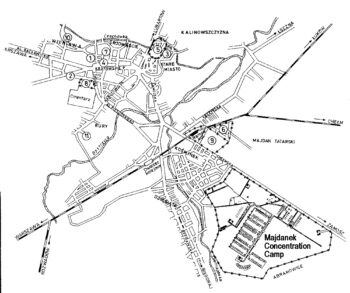
The decision to set up a concentration camp for 25,000 to 50,000 inmates in the southeastern suburbs of the southeast-Polish city of Lublin was made on 20 July 1941. It was meant to supply a slave-labor force for Himmler’s ambitious Generalplan Ost aiming at the colonization, development and Germanization of territories in Eastern Europe. After the initial success in the war against the Soviet Union, large numbers of Soviet PoWs were meant to occupy the camp. The first plan for the camp, labeled a PoW camp and meant to hold 125,000 inmates, dates from 7 October 1941. The camp’s nickname “Majdanek” – never used in official German documents – can be traced back to the nearby Lublin city district Majdan Tatarski.
Construction work began in October 1941 using Jewish-Polish and Soviet PoWs. The camp was huge. The first layout provided for ten camp sectors with a total of 236 barracks, 207 of them for lodging inmates. These plans changed repeatedly over time, and in the end, of eight planned camp sectors, only five were finalized, with just over a hundred barracks. One reason for the constant changes in plans was that the camp’s planned purpose changed as well. It started out as a PoW camp, received dual-purpose status of both PoW camp and concentration camp in April 1942, and was converted to a mere concentration camp a year later.
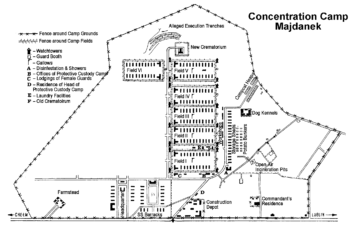
Similar to most other German concentration camps, living conditions in the camp were very harsh at the beginning, as everything had to be built from the ground up, meaning initially inmates had to sleep in the open, and there were no sanitary facilities or anything else. While private civilian companies, many of them Polish, did the detailed planning and provided skilled labor, inmates made up the unskilled labor force. The large presence of Polish civilians on the camp’s construction sites made it easy for the inmates – and for the resistance movement in particular – to communicate with the outside world.
For many months, the city administration of Lublin refused to connect the camp to the local drinking water, city gas and sewer system. This was resolved only after top officials from Berlin intervened. It still took until early 1943 for the camp to be connected to the sewer system, and the drinking water system in the camp was finalized only in the fall of that year. Before that, well water infested with bacteria was used, and during winter, snow was melted to obtain water. The camp’s first laundry facility was available only in early 1943. As a consequence, the camp’s hygienic conditions remained dreadful for a long time, resulting in persistently appalling living conditions. With the outbreak of epidemics (typhus, dysentery, tuberculosis), this led to catastrophically high death rates, far worse than in any other camp of the Third Reich (except maybe Auschwitz during its cataclysmic typhus epidemic from mid-1942 to mid-1943). Medical care was almost non-existent initially, and then improved only with the slowly improving sanitary conditions. A careful study of the extant documentation results in a total death toll due to “natural” (non-homicidal) reasons of some 42,200 during the camp’s entire existence. Some 20,000 inmates were released, hardly any of whom ever made any mass-murder claims.
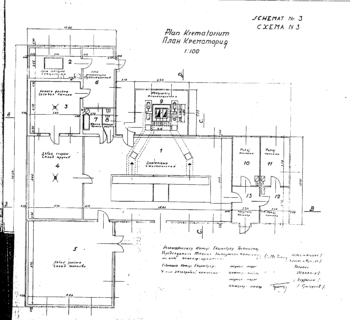
Logistical problems prevented the mass transfer of Soviet PoWs from Russia, so only relatively few of those, mostly transferred from other PoW camps in the region, were lodged in Majdanek. Bottlenecks in transporting the required construction materials eventually led to a downgrading of Himmler’s ambitious Generalplan Ost project. Rather than for PoWs, the camp was then used to incarcerate Polish inmates who had resisted the German occupational forces, as well as Polish Jews and Jews deported from Western and Central European countries. Once the basic camp infrastructure was set up, the camp’s inmates were increasingly employed in various local industries, in particular several SS-owned operations set up inside or right next to the camp, with a focus on manufacturing or recycling clothes and shoes for the German armed forces.
In the context of the Holocaust, four buildings are of interest: the crematorium, and the two disinfestation barracks “Bath & Disinfection I” and “Bath & Disinfection II,” together with the fumigation facility next to them.
The crematorium was planned as early as October 1941, but became operational only in January of 1944, hence operated only for six months before the Soviet conquest of the camp. It was equipped with five single-muffle cremation furnaces set in one large brick structure. To have any cremation options at all during the early phase of the camp, two mobile oil-fired furnaces were installed in a shed in 1942, but due to a lack of oil, they operated only for six months, and were then dismantled. (For details, see the Majdanek section of the entry on crematoria.)
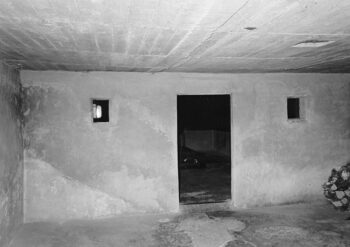
According to a construction-progress report of the Majdanek Camp’s Central Construction Office dated 22 October 1942, the buildings “Bath & Disinfection I” and “Bath & Disinfection II,” in the camp’s numbering systems Barracks No. 41 and 42 (or Buildings XIIA and XII in a different system), were the only delousing and bath facilities for inmates at that time. In fact, initially only “Bath & Disinfection II” was equipped with a delousing facility. Construction work to convert one of the rooms of “Bath & Disinfection I” into a fumigation chamber (called “gas chamber” in the documents) started only in late 1942 by adding two ventilation chimneys in its roof.
Numerous documents exist, starting in May 1942, for the construction of a separate Zyklon-B disinfestation facility next to “Bath & Disinfection I,” which was to be used for delousing clothes of the “Fur and Clothing Works” of Lublin. The original plan provided for two parallel rooms in a brick-and-mortar/concrete building, set beneath a large pole-support roof. Each room was to have two gastight steel doors. With a few modifications, this building was finished in late October 1942.
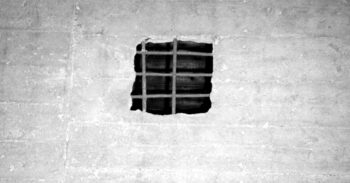
Several other projects to add more disinfestation facilities existed between 1941 and 1943, but it seems that few of them, if any, were carried out.
Propaganda History
Anything going on inside the Majdanek Camp was easily visible from nearby towns and roads. Furthermore, due to the ease with which information (and disinformation) could travel out of the camp as described before, the Polish resistance movement must have been well-informed about what was going on inside the camp, and most certainly communicated it (and the disinformation) to the Polish government in exile in London.
The first reference to a “gas chamber and a crematorium” at Majdanek were published by Polish periodicals in the UK in late 1942, and that wasn’t even wrong, if “gas chamber” here means “fumigation gas chamber.” Until May 1943, in 25 reports about Majdanek, not a single one mentions homicidal gassings, although one report claims mass murder of inmates by way of lethal injections. One long report of February 1943 – half a year after mass gassings are said to have started – describes the camp and its living conditions rather correctly, but without any references to gassing. It demonstrates the accuracy and completeness of information accessible to the Polish underground.
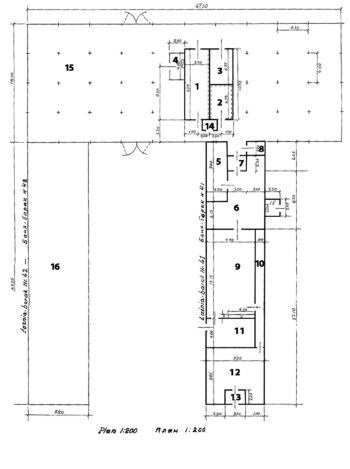
After the Auschwitz camp resistance had spread gas-chamber propaganda beginning in September 1942, the Polish underground reciprocated for Majdanek in May of 1943, when homicidal gas-chamber claims were made on a few occasions in reports about that camp. This may have been triggered by a general increase in Allied and Polish gas-chamber propaganda after the German discovery of the mass graves of the Soviet’s murder victims in Katyn. The rare reports about gassings at Majdanek, however, remained without any specific details. Not even the type of gas was mentioned. One report mentioned painted gas-chamber windows to hide from the outside what was going on inside, but homicidal gas chambers most certainly would not have had any windows, or else the gassing victims would have smashed them before their demise.
In 1944, an account of an unnamed inmate was published who is said to have escaped from the camp in 1943. His description includes the claim that those unfit for work were killed in gas chambers, but his description of the alleged murder facility is a chaotic jumble of different parts of separate facilities that have nothing to do with one another. The facilities that were later “identified” as homicidal gas chambers are not mentioned at all. This witness’s claim that thousands were gassed every day, and that two million had been killed by the end of 1943 alone, put this account safely in the category of atrocity propaganda.
The propaganda tune changed completely after the Soviets had conquered the camp in late July 1944. First, the Soviets joined the Poles, formed an “expert commission” they called a Polish-Soviet Extraordinary Commission for Investigating the Crimes Committed by the Germans in the Majdanek Extermination Camp in Lublin, and finalized their report on 23 August. This document was later also submitted to the Nuremberg International Military Tribunal (IMT) as Document USSR-29 (see IMT, Vol. VII, p. 590). This report claimed a total of 1,500,000 victims of the Majdanek “extermination” camp. It described in detail six alleged homicidal gas chambers, and mentioned in passing a seventh chamber located in the crematorium building. The report also mentions gas vans – one witness spoke of a gas bus, another of a gas truck. As one proof for their mass-murder claim, the Soviets presented photographs of mountains of shoes which they had found in the shoemaker’s workshop. It was admitted only decades later that these shoes did not belong to murdered inmates but had been sent to Majdanek by various German authorities in order to have their material recycled there.
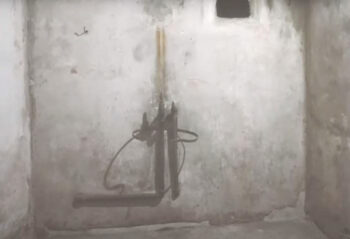
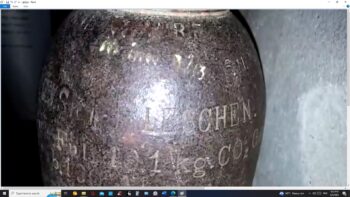 Steel bottle containing non-lethal carbon dioxide hooked up to the above contraption for the last several decades. A museum fraud. (Click on image to enlarge.)
Steel bottle containing non-lethal carbon dioxide hooked up to the above contraption for the last several decades. A museum fraud. (Click on image to enlarge.)With this “expert report” in hand, the Soviets started a propaganda blitz the world had never seen before. At its center were the burned-out ruins of the Majdanek crematorium with its five furnaces. Photos taken by the Soviets showed the furnaces with partly burned human corpses inside and human skeletons lying on the ground in front of them. Media representatives of all Allied nations were invited and given a camp tour. During a press conference on 25 August 1944, the Soviets told the gruesome tale of Majdanek having been a death factory where “roughly two million innocent people” had been murdered by the Germans “by every method of mass murder.”
Furthermore, the Polish-Soviet Commission also appointed a committee of “experts” who wrote a report on the alleged capacity of the five cremation furnaces found at the Majdanek Camp. They claimed that this furnace, built by the Kori Company, operated at a temperature of 1,500°C, that four bodies were stuffed into each muffle concurrently, and that it took a mere 12 minutes to cremate such a load, resulting in a daily capacity of just under 2,000 bodies. For the six months that this facility operated, this would amount to a maximum capacity of some 360,000 bodies.
That was still not enough, though, because the Polish-Soviet commission claimed in its report submitted to the IMT that 600,000 bodies had been cremated in that facility – plus 400,000 on pyres, 80,000 in the old crematorium with its two oil-fired furnaces, and 300,000 corpses had been buried in mass graves.
It is a fact, however, that the Kori furnace’s muffle had been designed to accommodate only one body at a time, which took roughly one hour to cremate. It could also not operate safely beyond a temperature of some 1,000°C. At higher temperatures, the refractory material becomes soft and starts to slowly flow (sinter), among other things also fusing with bones placed on it. Since the furnaces show no signs of sintering to this day, it is clear that they never operated at temperatures beyond 1,000°C. Their actual theoretical daily capacity of a 20-hour operating day was thus 100 bodies, or some 18,000 for half a year. (For more details on this furnace, see the entry on crematoria).
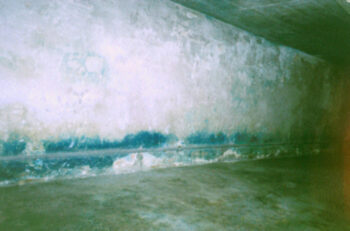
An analysis of witness testimony collected by Polish authorities between 1945 and 1947 shows that they are mostly based on hearsay, and rarely contain any specifics that would allow any critical assessment. A few witnesses who gave at least a modicum of information located “the” gas chamber either inside the crematorium or next to the inmate shower room, two locations which today are ruled out even by the Majdanek Museum. (See Alvarez 2023a for that overview.)
To this day, orthodox sources sometimes erroneously present the shower room inside Barracks 41, equipped with large windows, as “the gas chamber.” Most prominent in this regard are Alain Resnais’s 1955 documentary Nuit et Bruillard (Night and Fog, starting at 22 min 35 sec), the 2013 BBC documentary Treblinka: Inside Hitler’s Secret Death Camp featuring British archeologist Caroline Sturdy Colls (starting at 19 min 18 sec), and the 2000 Encyclopedia of the Holocaust by Robert Rozett and Shmuel Spector. They use a photo of this room to illustrate their entry on “gas chambers,” of all things (p. 230), while images of the rooms actually claimed to have been homicidal gas chambers at Majdanek are abundantly available. Rozett and Spector also mendaciously present a 1945 Soviet photo of a pile of shoes as belonging “to victims of the Majdanek camp” (p. 312).
While film directors such as Resnais and journalists of the BBC may claim ignorance, leading orthodox Holocaust scholars such as Rozett and Spector don’t have that excuse. If incompetence is ruled out, all that is left is malice. This impression gets supported by the fact, that the 1948 death-toll figure of 360,000 is repeated in their Majdanek entry three times (pages 312 and following), even though Polish historian Czesław Rajca had reduced the death toll in 1992 to 235,000 (see the next section).
Comparing this entry to the one in Gutman’s 1990 encyclopedia reveals that Rozett and Spector copied parts of the Majdanek text from Gutman. They took time and effort to rephrase the text to make this act of plagiarism less obvious. However, this time would have been spent better by updating this entry to the state of orthodox knowledge prevailing in 2000.
Death-Toll Propaganda
While the Soviets mentioned a death toll of “roughly two million” during their August 1944 press conference, the Polish-Soviet commission reduced that number slightly to 1.5 million. During the Polish show trial against six former Majdanek camp guards, staged at Lublin in late 1944, this number was increased again to 1.7 million, which the Polish government submitted as a court-proven fact during the Nuremberg IMT (IMT, Vol. VII, p. 214).
Once the hysterical anti-German frenzy of the war’s last phase and the immediate postwar years had somewhat subsided, Polish investigative judge Zdzisław Łukaszkiewicz took a second look at the Majdanek Camp, and concluded in 1948 that “only” some 360,000 inmates had died in that camp.
Once the Soviet Union collapsed, thus freeing Poland from its communist propaganda shackles, two more death-toll reductions followed. The first by Polish historian Czesław Rajca from the Majdanek Museum set the new number at 235,000 in 1992.
In the meantime, Western historians published all kinds of claims about Majdanek’s death toll, ranging from some 1.4 million by Lucy Dawidowicz in 1979 down to “tens of thousands” by Raul Hilberg in 1961, which gives the impression of a bunch of bungling schoolchildren rather than scholars doing proper research. Basing itself on this shaky ground, the verdict of the Düsseldorf Majdanek Show Trial announced in 1981 a death toll of at least 200,000 victims.
Thirteen years later, the Majdanek Museum’s new director, Polish historian Tomasz Kranz, reduced that death toll much more radically to just 78,000, and he also threw overboard five of the seven gas chambers which the Soviets had originally claimed in their report. Hence, according to the narrative en vogue since 2005, allegedly only two homicidal gas chambers ever existed at Majdanek.
Therefore, of the “roughly two million” victims of the Majdanek Camp claimed in 1944, not even four percent were left in 2005.
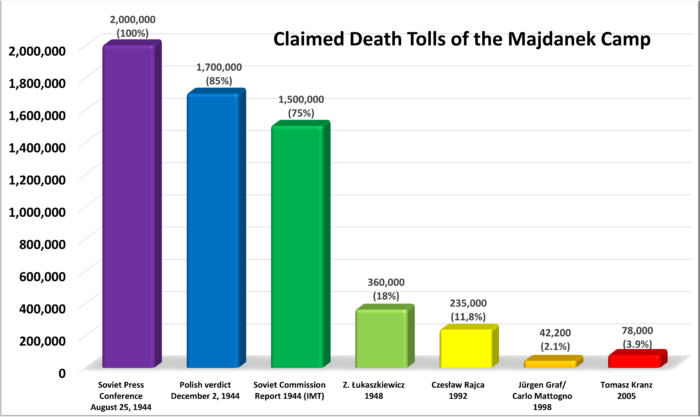
Forensic Findings
The Polish-Soviet Commission’s attempt to substantiate the magnitude of their mass-murder claims with forensic findings were a dismal failure. In mass graves at the claimed location, they found the remains not of the claimed 300,000 victims, but only of 733 bodies. Instead of finding ashes of the burned bodies of over a million people, they only found an amount corresponding to some 3,000 victims.
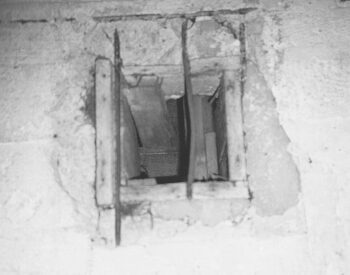
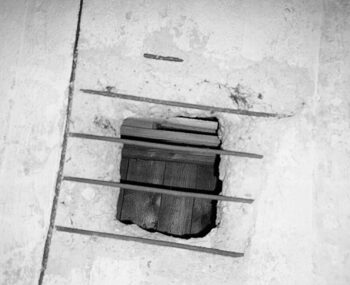 Majdanek, disinfestation wing, ceiling of Room 3: as before. Claims that Rooms 2 and 3 served as Zyklon-B homicidal gas chambers were dropped around the year 2000, because neither room has any ventilation system.
Majdanek, disinfestation wing, ceiling of Room 3: as before. Claims that Rooms 2 and 3 served as Zyklon-B homicidal gas chambers were dropped around the year 2000, because neither room has any ventilation system.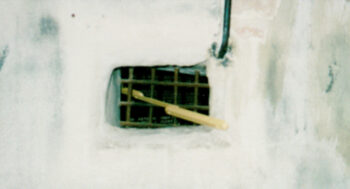 Majdanek, disinfestation wing, wall opening between Room 1 and Room 14 with steel bottles. The opening has no window pane, and no sign that it ever had one. In other words, poison gas could not have been used without the “observing” SS man dying himself. (Click on image to enlarge.)
Majdanek, disinfestation wing, wall opening between Room 1 and Room 14 with steel bottles. The opening has no window pane, and no sign that it ever had one. In other words, poison gas could not have been used without the “observing” SS man dying himself. (Click on image to enlarge.)The first government-independent forensic investigation was made in early 1988 by Fred Leuchter, then the U.S.’s only expert for execution technologies. Since it was carried out in a rush with a narrow deadline for an ongoing trial (the Second Zündel Trial), it was inevitably superficial. That same year, French historian Jean-Claude Pressac tried remedying this by providing a more-detailed discussion of the material aspects of the seven claimed homicidal gas chambers of the Majdanek Camp. While he made a few mistakes himself, he confirmed that most of the seven claimed homicidal gas chambers could not have operated as such.
Further research by skeptical scholars Jürgen Graf and Carlo Mattogno revealed in 1998 that all gas-chamber claims are untenable for numerous technical reasons, and that all actual gas chambers exclusively served as disinfestation chambers, as is also shown by documents.
Current Orthodox Narrative
Cornered by the results of skeptical forensic and archival research, orthodox historians have in the meantime abandoned five of the originally claimed seven homicidal gas chambers, but resurrected the gas van rumors, with nothing but disparate witness statements to back it up with.
In addition, they keep insisting that in early November 1943, when all efforts of the Third Reich were focused on recruiting as many slave laborers as possible for the war effort, and to keep them fit for work, the Majdanek camp authorities allegedly decided to murder some 18,000 Jews. The claimed mass shootings within just one day raise insurmountable logistical issues that the orthodoxy assiduously avoids. (For more details on this, see the entry on Operation “Harvest Festival”.)
Here is the current orthodox stance with regard to the various homicidal gas-chamber claims of the past:
- The alleged gas chamber inside the crematorium is a windowless room in the center of that building. It has no ventilation system, two wall openings to a neighboring room that could not be closed, and a crudely broken-through hole in the concrete ceiling, with reinforcement bars left where they were, allegedly representing a Zyklon-B introduction hole. Evidently, this room could neither be closed nor ventilated. Hence, it could not have served as a gas chamber, homicidal or not. Therefore, this room was silently rebranded in the early 2000s as a morgue (which it was according to wartime blueprints), and the embarrassing fake Zyklon-B hole in the ceiling, probably added by the Poles to sell this room as a gas chamber, is never mentioned at all.
- The two alleged gas chambers next to the camp’s laundry, which have always been mere drying facilities, were quietly dropped. No one talks about them anymore.
- The Zyklon-B disinfestation chamber next to the inmate shower room of Barracks 41 (“Bath and Disinfection I”), once the main “gas-chamber” tourist attraction of the camp, is now declared as what it was: a place to delouse clothes. The two openings in its roof, formerly mislabeled as Zyklon-B introduction holes, are now properly named ventilation shafts. This room’s window no longer causes embarrassing questions by visitors: “Wouldn’t the victims have smashed that in?” And neither does the fact that the room’s entry and exit doors open inward, hence would have been blocked by dead bodies during homicidal gassings. Furthermore, the doors had no locking mechanism, and the northern door is made of thin wooden boards that would have been unable to withstand a panicking crowd.
- All that is left standing is the disinfestation building next to “Bath and Disinfection I,” and here only two of the three rooms. These two rooms have a pipe running along the wall, allegedly to feed in carbon monoxide. Since carbon monoxide is harmless to insects, the purpose was not to kill these pests. However, the only gas bottles ever found in the camp contained carbon DIoxide, which is not toxic to humans. Furthermore, both rooms allegedly also served to kill with Zyklon-B. However, the larger one of the two has no means of inserting it. The two smaller rooms have crudely knocked out holes in the concrete ceiling, a similarly botched job as that in the crematorium. While one of these two rooms allegedly served to kill (either with carbon monoxide through the pipe or with Zyklon B through the hole), the other has been dropped. But if the ceiling hole in that room does not prove homicidal use (or in the crematorium room), then why does it prove such use in the other room?
The reason why the orthodoxy maintains these ludicrous gas-chamber claims is very simple: If they followed where the evidence inevitably leads, they would have to concede that all government reports, all court decisions, and all witness testimonies claiming otherwise were profoundly wrong. And if they were profoundly wrong about Majdanek, why should anyone believe that they were more accurate regarding gas-chamber claims about other camps?
And indeed, why should we? To prevent a disastrous de-holocausting domino effect, they desperately cling to some semblance of homicidal gassings.
What they do not realize is that the difference between the initially claimed 1.5 to 2 million victims and the current death toll of just 78,000 already completely eviscerates their credibility. The game is already over. The reason why this house of cards hasn’t collapsed yet is that, due to the ongoing disinformation campaign combined with threats of prosecution, the public at large hasn’t been informed about this orthodox disaster yet. Only a propagandistic window dressing keeps up the illusion.
(For details on Majdanek, see Graf/Mattogno 2012; Rudolf 2023, pp. 18-21, 295-303; as well as Alvarez 2023a.)

Barrack 41: The author neglects to mention that both doors open inward which is the death nail of this room as a gas chamber. The dead would be in the way of the doors being able to open
North door too flimsy to hold a crowd of people in the room
[Editors’ remark: We have adjusted the text to reflect this.]